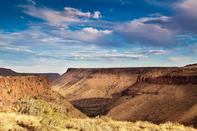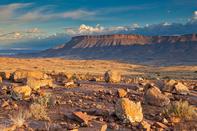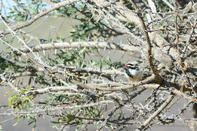Park Geology
From the summit of the Nuweveldberg in the Karoo National Park, one looks out over the Great Karoo 'vlaktes', and the Swartberg Mountains in the far distance. Also visible to the informed visitor are the geological surfaces of the higher Gondwana surface, from before Gondwanaland broke up, and the lower African surface, eroded away since the breakup of this former composite southern landmass.

In spring, Ursinia blooms beautify on the cracked face of Namaqualand. The extent to which these annuals bloom each year depends on the amount of seasonal rain over the past few years. Being a dry area, it is unusual to have a widespread outburst as lovely as this more than once or twice in a decade.
The Voortrekkers who ambled across the Karoo's open plains, between those typically flat-topped koppies, did not realise that they were passing through one of the earth's greatest natural wonders. Few of today's hasty travellers who speed across the seemingly monotonous interior, are aware of this either.
But to travel through the Karoo can be like taking a journey through time, as if one were flipping through the early volumes of an encyclopaedia called 'Life on Earth', without really understanding the text. The language here is palaeontology and the letters are the bones of creatures that lie fossilized in the alternating layers of purple and blue-green mudstones, and creamy-yellow sandstones of the Karoo Supergroup of rocks, which covers about two-thirds of South Africa.
Riverine Rabbit
Sheep. Sheep and goats. Sheep and goats and people. These three culprits have reduced the riverine habitat of the Karoo to such an extent that the little thumpers that live there are now classified as critically endangered.
Riverine rabbits are particular when it comes to their environment. They reside around watercourses, as they are the richest pacts of an ecosystem, but unfortunately everyone and everything else wants to be there too. In an attempt to save the species, specialists at the Karoo National Park are trying to breed them.
Fossils

The great attraction of the Karoo National Park near Beaufort West is one that takes a little time to appear. Yes, it's very beautiful with its backdrop of flat-topped mountains and scrubby vegetation; yes, there are rhinos, zebras, springbok and all manner of game that occur naturally in the Karoo. It's what used to be there that's really fascinating.
The park has a Fossil Trail that takes you on a journey, through aeons, to the first forms of plant life, through various stages of evolution to the mammal-like reptiles that dominated the Karoo before dinosaurs. It makes your own life feel like just a heartbeat in history.
Birdlife

The Karoo National Park protects a tract of mountainous Karoo landscape and boasts a good selection of Karoo specials, including three elusive, rock-loving species: cinnamon-breasted warbler, African rock pipit and short-toed rock thrush. Bird life in the park, as in all semi-arid regions, fluctuates markedly according to climatic conditions (it’s best after good summer rains).
Take a walk around the main campsite, set in dense acacia thicket, and you’ll encounter some of the best birding in the reserve. A good day’s twitching in the camp alone can yield 50 species, including Namaqua warbler, southern tchagra, acacia pied barbet, cardinal woodpecker, dusky sunbird, pririt batis, titbabbler and fairy flycatcher.
 The Karoo, which is the semi-desert region of South Africa, is best experienced from its heart, Beaufort West. Known as the oldest town in t...
The Karoo, which is the semi-desert region of South Africa, is best experienced from its heart, Beaufort West. Known as the oldest town in t... Located in the Great Karoo Area near Beaufort West in the Western Cape, the Karoo National Park covers over 75 000 ha of land dedicated to p...
Located in the Great Karoo Area near Beaufort West in the Western Cape, the Karoo National Park covers over 75 000 ha of land dedicated to p...